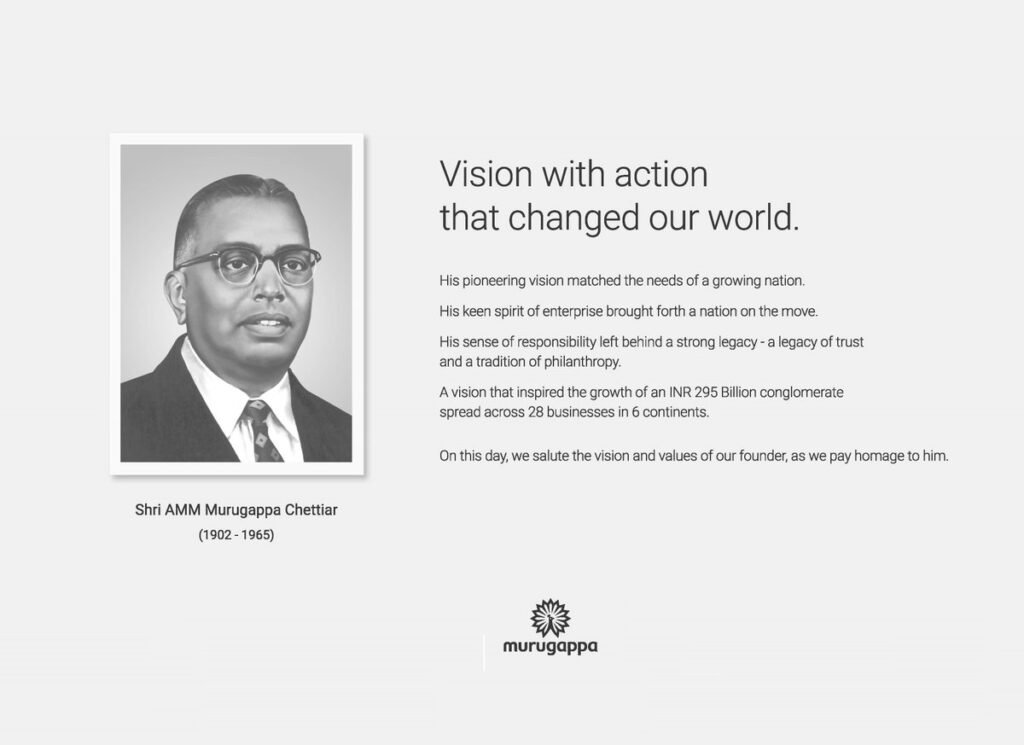The Murugappa Group – A Successful Behemoth

The Group has expanded rapidly, creating industry leaders in key areas such as agri-solutions, finance, and engineering.
A.M. Murugappa Chettiar, at 14 years old, became an apprentice at his uncle’s moneylending company in Burma (now Myanmar) in 1900, He belonged to the Tamil Chettiars, who had long made a living in the financial sector.
By learning Burmese, the young Chettiar was able to make connections and get a deeper understanding of the business.

In 1915, Murugappa Chettiar and his relative Ramanathan Chettiar established AMMRM, a banking company in Moulmein. Soon after, Murugappa Chettiar bought his business partner out.
Chettiar established himself in the financial sector between 1915 and 1934, and then expanded into textiles, rubber plantations, insurance, and stockbroking. Malaysia, Vietnam, and Sri Lanka were all markets he explored for his enterprise.
Strategically relocating its assets back to India just before the Japanese invasion of Burma in 194, Chettiar was forced to begin from scratch, yet this proved important for the organization.
In the years before India got its independence, Murugappa Group grew its business in India, especially in the south. It branched out into new areas to meet the evolving demands of the market. The Murugappa started a business that made steel safes, emery paper, an insurance company, and plantations. They diversified to become one of south India’s biggest and best-run family enterprises.
Growth
The Chennai-based company used mergers and acquisitions to accelerate its expansion in independent India. Many partnerships fail because partners lose interest over time when the business undergoes management or strategic changes, or because of an acquisition. Their close and trustworthy relationship with the Murugappa allowed them to resell their shares to the family at prices that were profitable for them. The company has been around for more than 115 years and has gone through more than 50 mergers and acquisitions.
The Murugappas’ interest in business partnerships was whetted during their time at Tube Investments of India Ltd. (TII). The collective set out to create a company that would mass-produce an item accessible to the masses, and bicycles seemed like a natural fit. So, in 1949, TI Cycles of India was set up as a business that put together bicycles with the help of a British company.
The company’s success prompted the decision to implement backward integration by establishing a steel tube manufacturer and a chain manufacturer. Some time afterwards, TII expanded into the engineering and metals industries. The third generation also began working there about this time.
A member of the family would always see the profit possibilities in an impending crisis. It was predicted that as World War I approached, British ships would import fewer and fewer items. The organisation decided to buy a sandpaper factory and enter the abrasives market because it saw an opportunity to create jobs in the area.
The group was started in 1954 by a partnership between Murugappa, American Carborundum Inc., and British Universal Grinding Wheel Co. Ltd. It grew through more than six acquisitions to become a global leader in a wide range of abrasives, electro-minerals, industrial ceramics, and refractories.
The Murugappa Group’s purchase of EID-Parry (India) Ltd. in 1981 made news since it was the second-oldest commercial brand in India. The business established India’s first sugar factory in 1842 in the Tamil Nadu village of Nellikuppam. In addition to sugar production, the company was also involved in the production of fertilisers, insecticides, and sweets.
Creditors of Parry, which had been plagued by labour disputes, asked the Murugappa Group to assume control of the company. Until it was given complete control of the publicly listed corporation, the family repeatedly rejected the offer.
Governance
Murugappa Group, which had turned around in the years leading up to economic liberalisation in 1991, spent the next decade honing in on their strengths and investing heavily in R&D.
The deaths of third-generation M.V. Arunachalam and M.A. Murugappan in 1996 led to the creation of a succession plan that is unusual for Indian family-run businesses.
In 1999, M.V. Subbiah, grandson of company founder A.M. Murugappa, stepped down, paving the way for a new management structure. Members of the Murugappa family are in the minority on the company’s board of directors; thus, they stepped down from running particular divisions of the firm to focus on board roles. The board had three independent outside directors, three executive directors, and two people from the same family.
Over time, the Murugappa Corporate Board was disbanded.
While that’s admirable, it seems like the Murugappa Group has hit paydirt when it comes to preserving the peace inside the family. Despite some little differences here and there, it seems like everyone is still on the same page.
Since the 1970s, Murugappa Management Services (MMSL), which is run by the Murugappa family, has been providing management services. In July 1972, it was formed as a public limited company with no public stock. It was reorganised as a private limited corporation in February 2022.
It’s important to note that no relatives work for or are otherwise involved with the firm. The same is true with the company’s board of directors; none are present. Most of its stock is owned by public firms affiliated with the Murugappa family. According to available information, they individually own less than 20% of the company.
Some of the top executives of publicly traded Murugappa companies serve as directors for this management business. So far, the company hasn’t had to answer any questions about possible conflicts of interest that could arise from doing business with related parties.
When a firm is publicly traded, it is subject to more regulations and is automatically viewed more favourably than one that is closely held. Maybe that’s why the MMSL founders created the organisation the way they did.
Through its role as a supplier to the companies in the Murugappa Group, MMSL provides essential support services, including office security, guest house maintenance, and travel arrangements. Once called Tiam House Services Ltd., its name changed in the 1990s to what it is now.
Even after they retire, senior members are paid by the MMSL firm for their time and advice.
Perhaps the only business family in the nation, the Chennai-based group’s members retired from management upon attaining the mandatory retirement age of 65. After 65 years, however, several former Murugappa Group Corporate Board members have returned to active management after the board’s dissolution. Maybe things have shifted in their context. A new order may have been established by doing this.
The group’s most talented members often take leadership roles in the group’s most successful businesses, such as Tube Investments, CUMI, Cholamandalam Finance, EID Parry, and others. Some others find shelter in the affiliated real estate firms. Otherwise, there’s always MMSL for the rest of us.
By doing so, we can ensure that everyone’s needs are met. This policy of consideration is in addition to the dividends that family members get regularly from the holding company of the group for their ownership stake in the business.
The elders of the family have worked to keep disputes to a minimum. In addition, the fact that they are generally uncomfortable in the spotlight has served to keep the Murugappa gang together and shield them from unnecessary scrutiny.
The Murugappa Group has grown into a conglomerate with a market capitalization of INR 547 billion and a great reputation for developing values and honestly running its business.



